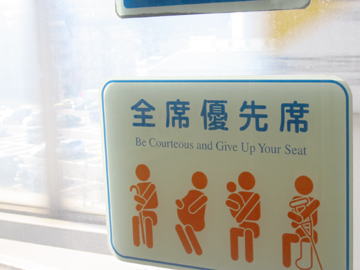Full trains and priority seats
Including Tōkyū Tōyoko line, the trains are usually full of commuters in the morning and evening, especially because the passengers take the trains in the morning so that they can be in time for their offices or schools.
These trains are packed so tight that passengers are restrained from reading books or magazines, and even holding straps or handrails. Of course that doesn't enable them to sit on seats.
They don't look angry, but surely seem to be annoyed with the jam; however, they can do nothing. Their mobile phones, magazines, and newspapers hit others' backs and shoulders every time the train shakes, which also annoys them. Who could accept such a crowded condition other than in a commuter train?
Priority seats
Though trains in the daytime are, of course, not crowded as in the rush hours, it's not always possible to get a seat. However, we mustn't forget that there are some passengers whom we should offer seats to in consideration for their handicaps.
In trains run by Tōkyū Corporation some seats are especially reserved for elderly or handicapped persons, expecting mothers, and passengers accompanying small children. These are called priority seats. Perhaps all commuter trains (except express trains) running in Japan have these seats.
Priority seats are not for the persons' exclusive use, so fundamentally all passengers can use all seats including priority seats. And if a person who really needs a seat comes into the train and the train is so crowded that he/she cannot sit on any seat, it should be enough to offer one of the priority seats to him/her.
On the other hand, trains are frequently crowded. If the priority seats are all occupied, the person may think that it is shameful to receive a seat from someone while other passengers are still standing. Then he/she may refrain from using the seat and finally give up to be seated. What a waste of time, effort, and the seats that is.
Is it not natural that not only the priority seats but all seats should be offered to each passenger? It would then be unnecessary to label priority seats.
Tōkyū doubled the number of priority seats, but not all elderly persons who need the seats, for example, can use the seats, because they are already full. We need to consider why priority seats are reserved.
 Yokohama Municipal Transport Bureau pioneered a unique strategy to improve its priority seats on December 1st, 2003. All the seats of its subway are priority seats.
According to its webpage: "Please offer your seat to elderly or handicapped persons, expecting mothers, and passengers accompanying small children. We, Yokohama Municipal Subway, would like to make an environment that passengers can comfortably offer their seats to each other" (Yokohama Municipal Transport Bureau, 2004).
This strategy wholly appeals to passengers for their cooperation, and I can agree with its purpose. It seems that no other railways take such large-scale plans to increase the number of priority seats. But I only cannot agree with its steps -- calling all seats as priority seats.
Yokohama Municipal Transport Bureau pioneered a unique strategy to improve its priority seats on December 1st, 2003. All the seats of its subway are priority seats.
According to its webpage: "Please offer your seat to elderly or handicapped persons, expecting mothers, and passengers accompanying small children. We, Yokohama Municipal Subway, would like to make an environment that passengers can comfortably offer their seats to each other" (Yokohama Municipal Transport Bureau, 2004).
This strategy wholly appeals to passengers for their cooperation, and I can agree with its purpose. It seems that no other railways take such large-scale plans to increase the number of priority seats. But I only cannot agree with its steps -- calling all seats as priority seats.
Indeed the bureau says its priority seats are not exclusive seats, but I worry about the meaning of 'priority.' Since the idea of priority is based on cooperation and kindness, it seems necessary to call for consideration rather than to increase the number of seats.
Priority seats in the corner of a train surely represent an attitude toward the seats in the corner of every passenger's heart. Priority seats should be made from the passengers' concern.
Work cited:
Yokohama Municipal Transport Bureau (2004) "Shiei chikatetsu wa subete no zaseki ga yūsen-seki desu" (All seats are priority seats in [Yokohama] municipal subway)
[NEXT] Cellular phones
[TOP]
[Intro] [Boarding] [Smoking] [Priority] [Phones]
[Vacant] [Comfort] [13th] [Shinjuku] [Hommoku]
Soliloquy of my Railway © Satoshi Oshio, 2004


 Yokohama Municipal Transport Bureau pioneered a unique strategy to improve its priority seats on December 1st, 2003. All the seats of its subway are priority seats.
According to its webpage: "Please offer your seat to elderly or handicapped persons, expecting mothers, and passengers accompanying small children. We, Yokohama Municipal Subway, would like to make an environment that passengers can comfortably offer their seats to each other" (Yokohama Municipal Transport Bureau, 2004).
This strategy wholly appeals to passengers for their cooperation, and I can agree with its purpose. It seems that no other railways take such large-scale plans to increase the number of priority seats. But I only cannot agree with its steps -- calling all seats as priority seats.
Yokohama Municipal Transport Bureau pioneered a unique strategy to improve its priority seats on December 1st, 2003. All the seats of its subway are priority seats.
According to its webpage: "Please offer your seat to elderly or handicapped persons, expecting mothers, and passengers accompanying small children. We, Yokohama Municipal Subway, would like to make an environment that passengers can comfortably offer their seats to each other" (Yokohama Municipal Transport Bureau, 2004).
This strategy wholly appeals to passengers for their cooperation, and I can agree with its purpose. It seems that no other railways take such large-scale plans to increase the number of priority seats. But I only cannot agree with its steps -- calling all seats as priority seats.